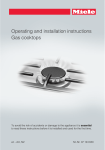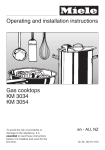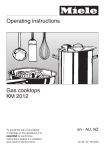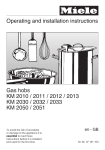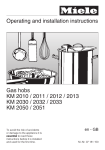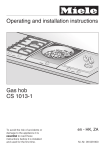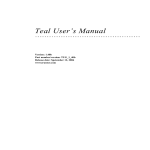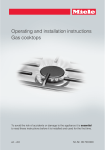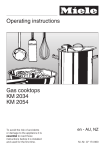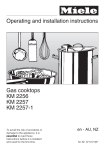Download Miele KM 3014 Operating instructions
Transcript
Operating and installation instructions Gas cooktop KM 3014 To avoid the risk of accidents or damage to the appliance, it is essential to read these instructions before it is installed and used for the first time. en - AU, NZ M.-Nr. 09 317 790 2 WO This appliance can be used in countries other than those specified on the appliance. It is, however, set up for connection to the gas and electricity supplies in the countries specified. For use in other countries please contact the Miele spare parts or customer service department in your country. 3 Contents Description of the appliance . . . . . . . . . . . . . . . . . . . . . . . . . . . . . . . . . . . . . . . . . 5 Cooktop . . . . . . . . . . . . . . . . . . . . . . . . . . . . . . . . . . . . . . . . . . . . . . . . . . . . . . . . . . 5 Accessories supplied . . . . . . . . . . . . . . . . . . . . . . . . . . . . . . . . . . . . . . . . . . . . . . . 7 Warning and Safety instructions . . . . . . . . . . . . . . . . . . . . . . . . . . . . . . . . . . . . . 8 Caring for the environment . . . . . . . . . . . . . . . . . . . . . . . . . . . . . . . . . . . . . . . . . 15 Before using for the first time. . . . . . . . . . . . . . . . . . . . . . . . . . . . . . . . . . . . . . . 16 Operation . . . . . . . . . . . . . . . . . . . . . . . . . . . . . . . . . . . . . . . . . . . . . . . . . . . . . . . 17 Control knobs. . . . . . . . . . . . . . . . . . . . . . . . . . . . . . . . . . . . . . . . . . . . . . . . . . . . . 17 Switching on . . . . . . . . . . . . . . . . . . . . . . . . . . . . . . . . . . . . . . . . . . . . . . . . . . . . . 18 In the event of a power cut . . . . . . . . . . . . . . . . . . . . . . . . . . . . . . . . . . . . . . . . 18 Regulating the flame . . . . . . . . . . . . . . . . . . . . . . . . . . . . . . . . . . . . . . . . . . . . . . . 19 Switching off . . . . . . . . . . . . . . . . . . . . . . . . . . . . . . . . . . . . . . . . . . . . . . . . . . . . . 19 Pots & Pans . . . . . . . . . . . . . . . . . . . . . . . . . . . . . . . . . . . . . . . . . . . . . . . . . . . . . 20 Combi insert . . . . . . . . . . . . . . . . . . . . . . . . . . . . . . . . . . . . . . . . . . . . . . . . . . . 21 Wok ring . . . . . . . . . . . . . . . . . . . . . . . . . . . . . . . . . . . . . . . . . . . . . . . . . . . . . . 21 Energy-saving tips . . . . . . . . . . . . . . . . . . . . . . . . . . . . . . . . . . . . . . . . . . . . . . . . 22 Safety features . . . . . . . . . . . . . . . . . . . . . . . . . . . . . . . . . . . . . . . . . . . . . . . . . . . 23 Cleaning and care . . . . . . . . . . . . . . . . . . . . . . . . . . . . . . . . . . . . . . . . . . . . . . . . 24 Problem solving guide . . . . . . . . . . . . . . . . . . . . . . . . . . . . . . . . . . . . . . . . . . . . 28 Optional accessories . . . . . . . . . . . . . . . . . . . . . . . . . . . . . . . . . . . . . . . . . . . . . . 29 Safety instructions for installation . . . . . . . . . . . . . . . . . . . . . . . . . . . . . . . . . . . 30 Safety clearances. . . . . . . . . . . . . . . . . . . . . . . . . . . . . . . . . . . . . . . . . . . . . . . . . 31 Appliance and building-in dimensions . . . . . . . . . . . . . . . . . . . . . . . . . . . . . . . 33 Installation . . . . . . . . . . . . . . . . . . . . . . . . . . . . . . . . . . . . . . . . . . . . . . . . . . . . . . 34 Electrical connection . . . . . . . . . . . . . . . . . . . . . . . . . . . . . . . . . . . . . . . . . . . . . . 36 Gas connection . . . . . . . . . . . . . . . . . . . . . . . . . . . . . . . . . . . . . . . . . . . . . . . . . . 37 Burner ratings . . . . . . . . . . . . . . . . . . . . . . . . . . . . . . . . . . . . . . . . . . . . . . . . . . . 39 Conversion to another type of gas. . . . . . . . . . . . . . . . . . . . . . . . . . . . . . . . . . . 40 Jet table . . . . . . . . . . . . . . . . . . . . . . . . . . . . . . . . . . . . . . . . . . . . . . . . . . . . . . . . . 40 Changing the main jets . . . . . . . . . . . . . . . . . . . . . . . . . . . . . . . . . . . . . . . . . . . . . 41 Changing the small jets . . . . . . . . . . . . . . . . . . . . . . . . . . . . . . . . . . . . . . . . . . . . . 43 Checking operation . . . . . . . . . . . . . . . . . . . . . . . . . . . . . . . . . . . . . . . . . . . . . . . . 44 After sales service, data plate . . . . . . . . . . . . . . . . . . . . . . . . . . . . . . . . . . . . . . 45 4 Description of the appliance Cooktop a Wok burner Controls knobs for the cooking zones b Small burner f Front right c Medium burner g Rear right d Pan support (for each burner) h Left e Cooking zone symbol 5 Description of the appliance Burners Wok burner a Outer burner cap b Inner burner cap c Burner head d Burner base e Ignition safety device f Ignitor Small and medium burner a Burner cap b Burner head c Burner base d Ignition safety device e Ignitor 6 Description of the appliance Accessories supplied The accessories supplied with your appliance, as well as a range of optional ones, are available to order from Miele (see "Optional accessories"). Wok ring The wok ring supplied with your appliance can be used in instances where extra stability is required. It is particularly suitable for woks with a rounded base. Combi insert The combi insert must be used if you wish to use a pot or pan with a smaller diameter base than the minimum given in the table. 7 Warning and Safety instructions Correct application This appliance complies with all relevant local and national safety requirements. Inappropriate use can, however, lead to personal injury and damage to property. To avoid the risk of accidents and damage to the appliance, please read these instructions carefully before using it for the first time. They contain important notes on installation, safety, use and maintenance. ~ This cooktop is designed for domestic use and for use in similar environments by guests in hotel or motel rooms, bed & breakfasts and other typical living quarters. This does not include common/shared facilities or commercial facilities within hotels, motels or bed & breakfasts. ~ This gas cooktop must only be used as described in these instructions. Any other usage is at the owner's risk and could be dangerous. The manufacturer cannot be held liable for damage resulting from incorrect or improper use or operation. Keep these instructions in a safe place and ensure that new users are familiar with the contents. Pass them on to any future owner. ~ The appliance is not suitable for Do not modify this appliance. ~ This gas cooktop is not intended for outdoor use. use by persons (including children) with reduced physical, sensory or mental capabilities, or lack of experience and knowledge, unless they are supervised whilst using it or have been given instruction concerning its use by a person responsible for their safety. ~ This appliance must not be installed and used in mobile installations such as ships etc. ~ Do not modify this appliance. 8 Warning and Safety instructions Safety with children ~ This appliance is only intended for use by adults who have read these instructions. This appliance is not a toy! To avoid the risk of injury, keep children well away and do not allow them to play with it or to use the controls. They will not understand the potential dangers posed by it. They should be supervised whenever you are working in the kitchen. ~ Packaging, e.g. cling film, polystyrene and plastic wrappings, must be kept out of the reach of babies and young children. Danger of suffocation! Dispose of or recycle all packaging safely as soon as possible. ~ Older children may only use the cooktop when its operation has been clearly explained to them and they are able to use it safely, recognising the dangers of misuse. ~ The appliance gets hot when in use and remains hot for quite a while after being switched off. To safeguard against burning, keep children well away from the appliance at all times. ~ Do not store anything which might arouse a child's interest in storage areas above or next to the appliance. Otherwise they could be tempted into climbing onto the appliance with the risk of burning themselves. ~ Keep all pans out of reach of children. Turn pan handles inwards away from the edge of the cooktop. Danger of burning or scalding! Special cooktop guards are available from good retail outlets. 9 Warning and Safety instructions Technical safety ~ Before installation, check the appliance for visible signs of damage. Do not install and use a damaged appliance. A damaged appliance is dangerous. ~ The electrical safety of this appliance can only be guaranteed when continuity is complete between it and an effective earthing system which complies with local and national safety regulations. It is most important that this basic safety requirement is present and tested regularly and, where there is any doubt, the household wiring system should be inspected by a qualified electrician. The manufacturer cannot be held liable for the consequences of an inadequate earthing system (e.g. electric shock). ~ Before connecting the appliance to the mains supply, make sure that the voltage and frequency details given on the data plate correspond to the on-site electricity supply, otherwise the appliance could be damaged. Consult a qualified electrician if in any doubt. ~ For safety reasons, this appliance may only be used after it has been built in. 10 ~ The connection to the gas supply must be carried out by a suitably qualified and competent person in accordance with current local and national safety regulations. If the appliance is supplied without a plug, or if the plug is removed, it must be connected to the mains electricity supply by a suitably qualified and competent electrician in strict accordance with current local and national safety regulations. The manufacturer cannot be held liable for damage caused by incorrect installation or connection. ~ Never open the housing of the appliance. Tampering with electrical connections or components and mechanical parts is highly dangerous to the user and can cause operational faults. ~ Installation, maintenance and repairs may only be carried out by a Miele authorised, suitably qualified and competent person in strict accordance with current national and local safety regulations. Repairs and other work by unauthorised and unqualified persons could be dangerous. Miele cannot be held liable for unauthorised work. Warning and Safety instructions ~ The gas cooktop must be disconnected from the gas supply and mains electricity before repairs and maintenance work is carried out. It is only completely isolated from the electricity supply when: ~ Do not use the cooktop if the – the mains fuse is disconnected, ~ In areas which may be subject to – the screw-out fuse is removed (in countries where this is applicable), – it is switched off at the wall socket and the plug is withdrawn from the socket, or it is switched off at the isolator. ceramic surface is cracked, chipped or damaged in any way. Switch it off immediately, disconnect it from the mains electricity and the gas supply, and call Miele. infestation by cockroaches or other vermin, pay particular attention to keeping the appliance and its surroundings in a clean condition at all times. Any damage caused by cockroaches or other vermin will not be covered by the warranty. ~ While the appliance is under warranty, repairs should only be undertaken by a service technician authorised by Miele. Otherwise the warranty will be invalidated. ~ Faulty components must only be replaced by genuine Miele original spare parts. The manufacturer can only guarantee the safety of the appliance when Miele replacement parts are used. ~ This appliance is not intended to be operated by means of an external timer or separate remote control system. ~ If the connection cable is damaged, it must be replaced by a suitably qualified electrician with a specialist connection cable of type H 05 VV-F (pvc insulated), available from Miele. ~ Do not connect the appliance to the mains electricity supply by a multi-socket unit or an extension lead. These do not guarantee the required safety of the appliance (e.g. danger of overheating). 11 Warning and Safety instructions Correct use ~ The appliance gets hot when in use and remains hot for quite a while after being switched off. Do not touch it whilst it could still be hot. ~ When using a rangehood above the cooktop, ensure that the burner is always covered with a pan when in use. Otherwise flames could be drawn up by the suction of the rangehood, parts of which could then be damaged or even set on fire. ~ Do not leave the cooktop unattended whilst it is being used. Boiling fat or oil could ignite and cause a fire. ~ If oil or fat does catch fire, do not attempt to put out the flames with water. Use a suitable fire blanket, saucepan lid, damp towel or similar to smother the flames. ~ Do not use the appliance to heat up the room. Due to the high temperatures radiated, objects near the appliance could catch fire. The life of the appliance could also be reduced. ~ For added protection, it is advisable to use heat-resistant pot holders or gloves when using the appliance. Ensure that they do not come into contact with the flames. Do not use large cloths, tea towels or similar as the ends could touch the flames and catch fire. Take care not to let these items get damp or wet as this causes heat to transfer through the material more quickly with the risk of scalding or burning yourself. 12 ~ Do not flambé under a rangehood. The flames could set the rangehood on fire. ~ Do not drop anything on the ceramic surface. Even a light object could cause damage in certain circumstances. ~ Do not use the appliance as a resting place for anything else. The article could melt or catch fire if residual heat is still present or if the appliance is switched on by mistake. ~ Do not cover the appliance, e.g. with a covering plate, a cloth, kitchen foil, etc. If the appliance is switched on by mistake, or if there is residual heat present, these materials may catch fire, shatter or melt. ~ Do not use plastic or aluminium foil containers on the cooktop. These melt at high temperatures and could catch fire. ~ Do not heat up unopened tins of food on the cooktop, as pressure will build up in the tin, causing it to explode. This could result in injury and scalding or damage. ~ Make sure all the components of the gas burners have been correctly assembled before switching on. Warning and Safety instructions ~ Pans must be the correct size for the burner they are used on (see "Pots & Pans"). A pan which is too small will be unstable on the pan support. If the pan diameter is too large, flames can spread out to the sides and damage or burn the worktop, wall claddings or surrounding units and also parts of the cooktop. Miele will not accept liability for any damage resulting from such incorrect use. ~ Ensure that the flames from the burner do not spread out beyond the base and up the sides of the pan. ~ Unless the pan manufacturer states that you can do so, do not use pans with very thin bases on this cooktop, and never heat up empty pans as they could get damaged. This could also damage the appliance. ~ Always use the pan supports supplied. Never place a pot or pan on the burner itself. ~ Do not store any inflammable objects near the gas cooktop. ~ Remove splashes of fat and other food debris from the surface as soon as possible. These are a fire hazard. ~ Replace the pan supports carefully to avoid scratching the surface of the cooktop. ~ Using the cooktop creates heat, moisture and products of combustion within the room in which it is located. It is important to make sure the room is sufficiently ventilated during operation of the cooktop with natural or mechanical means of ventilation, e.g. a rangehood. ~ If the cooktop is used for very long periods of time, additional ventilation of the room may be necessary, e.g. by opening windows or doors, or running the rangehood on the highest setting. ~ When using an electrical appliance, e.g. a hand-held mixer, near the gas cooktop, ensure that the connection cable doesn't come into contact with the hot cooktop. The insulation on the cable could become damaged, giving rise to an electric shock hazard. ~ Do not use or store flammable materials in the appliance storage drawer or near this appliance. Cutlery inserts must be heat-resistant. ~ Do not spray aerosols in the vicinity of this appliance while it is in operation. ~ Do not use pans that are large enough to cover more than one burner. The resulting build-up of heat could damage the appliance. 13 Warning and Safety instructions ~ If the cooktop is built-in behind a furniture door, it must only be operated when the door is open. Close the furniture door only once the appliance has been switched off and the residual heat indicators have gone out. ~ If the appliance has not been used for a long period of time, it should be thoroughly cleaned before it is used again. It is also advisable to have the appliance tested by a qualified person for safety. Miele cannot be held liable for damage caused by non-compliance with these Warning and Safety instructions. 14 Caring for the environment Disposal of the packing material Disposal of your old appliance or machine The transport and protective packing has been selected from materials which are environmentally friendly for disposal and can normally be recycled. Electrical and electronic appliances / machines often contain materials which, if handled or disposed of incorrectly, could be potentially hazardous to human health and to the environment. They are, however, essential for the correct functioning of your appliance or machine. Therefore, please do not dispose of your old machine or appliance with your household waste. Ensure that any plastic wrappings, bags, etc. are disposed of safely and kept out of the reach of babies and young children. Danger of suffocation. Rather than just throwing these materials away, please ensure they are offered for recycling. Please dispose of it at your local community waste collection / recycling centre and ensure that it presents no danger to children while being stored for disposal. It should be unplugged or disconnected from the mains electricity supply by a competent person. The plug must be rendered useless and the cable cut off directly behind the appliance or the machine to prevent misuse. 15 Before using for the first time Please stick the extra data plate for the appliance supplied with this documentation in the space provided in the "After sales service" section of this booklet. Cleaning for the first time ^ Remove any protective foil and sticky labels. ^ Clean all removable parts of the burners with a solution of warm water and a little washing-up liquid applied with a soft sponge. Dry all parts thoroughly after cleaning and then reassemble the burners (see "Cleaning and care"). ^ Before using for the first time, clean the appliance with a damp cloth only and then wipe dry. The metal components have a protective coating which may give off a slight smell when heated up for the first time. The smell and any vapours given off do not indicate a faulty connection or appliance, and neither are they hazardous to health. 16 Operation Control knobs The control knob is used to ignite the burner and to regulate the strength of the flame. Small, medium and large burners ßThe gas supply is turned off & Strongest flame / Weakest flame Wok burner ß The gas supply is turned off &/ Strongest flame: inner and outer burners burn on the highest setting. && Strong flame: outer burner on lowest setting, inner burner on highest setting. && Weak flame: outer burner is off, inner burner on highest setting. / Weakest flame: outer burner is off, inner burner on lowest setting. 17 Operation Switching on ^ To ignite the burner, press the control knob down and turn it anti-clockwise to the largest flame symbol. When a control knob is activated, a spark is generated on all burners. This is not a fault. ^ When the flame ignites, keep the control pressed in for 5-10 seconds, and then let it go. ^ Should the flame be extinguished earlier, turn the control knob to "ß". Wait at least 1 minute before trying again. If necessary, keep the control pressed in for longer. ^ If the burner does not ignite after a second attempt, turn the control back to "ß" and go to the "Problem solving guide" for advice. In the event of a power cut If there is an interruption to the electricity supply, the gas can be ignited with a match. ^ Press in the relevant control and turn it anti-clockwise to the largest gas symbol. ^ Hold the control pressed in and light the gas at the burner with a match. ^ Keep the control pressed in for a further 5-10 seconds and then release it. 18 Operation Regulating the flame Control the flame so that it does not spread out beyond the sides of the pan. As the outer part of the flame is much hotter than the centre, the tips of the flames should stay beneath the pan base. Flame tips which extend beyond the sides of the pan merely warm up the air in the room and can also damage pan handles and increase the risk of injury. The burners can be regulated at any level between the strongest and weakest flame. ^ To move from the high to the low setting, turn the control anti-clockwise until it meets a resistance. Then press it down and continue to turn it past the resistance before releasing it. You can now select the setting you require. ^ To move from the low to the high setting, turn the control clockwise until it meets a resistance. Then press it down and continue to turn it past the resistance before releasing it. You can now select the setting you require. Switching off ^ Turn the control clockwise to position "ß" . This stops the flow of gas and the flame goes out. Do not turn the control knob clockwise past "ß". 19 Pots & Pans Burner Small burner Medium burner Large burner Wok burner Min. pot/pan base diameter in cm 10 12 14 14 Max. diameter at top of pot/pan in cm Small burner Medium burner Large burner Wok burner 20 22 24 26 – Refer to the chart above and ensure that the pot/pan diameter falls within the minimum and maximum diameters given for the burner you are using. A pot/pan which is too small will be unstable on the pan support. If the pan diameter is too large, flames can spread out to the sides and damage or burn the worktop, wall claddings or surrounding units and also parts of the cooktop. The manufacturer cannot be held liable for this type of damage. – Remember when purchasing new pots and pans that manufacturers usually refer to the diameter at the top of the pan in their documentation. – Any heat-resistant pots and pans can be used on a gas burner. – Pans with thick bases are preferable as these distribute heat more evenly. With thin bases, there is a danger of food overheating in places. Stir the food frequently. – Select pots and pans which are suitable for the burner they are to be used on. In general: use larger diameter pans on large burners, and smaller diameter pans on small burners. – The pan support supplied with the appliance must always be used. Never place a pot or pan on the burner itself. – Position the pan centrally on the pan support so that it sits securely and cannot tip up. A little movement is quite normal and not a cause for concern. – Do not use pots or pans with base supports. 20 Pots & Pans Combi insert The combi insert must be used if you wish to use a pot or pan with a smaller diameter base than the minimum given in the table. It ensures pots and pans sit securely on the cooktop and cannot tip over. Wok ring Use the wok ring to give additional stability, especially to woks with a rounded base. Make sure that the wok ring is located securely in its correct position. Woks are different from other pots and pans. Woks have a small base diameter and large top diameter, generally between 35 - 40 cm. When using a wok, place it on the wok burner. 21 Energy-saving tips – Use a lid whenever possible to minimise heat loss. – Cook with as little water as possible. – Cooking times can be significantly reduced with a pressure cooker. – Reduce the power setting once the water has come to the boil or the oil is hot enough to fry in. – Wide, shallow pans are preferable to tall, narrow ones as they will heat up faster. 22 Safety features Thermo-electric ignition This appliance has a thermo-electric ignition safety device. If the flame goes out, for example if food has boiled over or if there is a sudden draught, and automatic re-ignition has been unsuccessful, the supply of gas to the burner will be cut off. ^ To use the burner again, turn the control clockwise to the "ß" position, and then switch it back on as normal. The safety cut-out operates independently from the electricity supply. This means that it will still work if the cooktop is used during a power cut (see "Use during a power cut"). 23 Cleaning and care ,Do not use a steam cleaning appliance to clean this appliance. The steam could reach the electrical components and cause a short circuit. – The appliance should be cleaned regularly, preferably after each use. Allow the appliance to cool down to a safe temperature before cleaning. – To avoid water marks and limescale deposits, use a soft cloth to dry surfaces that have been cleaned with water. – Stubborn soiling should be soaked first. – Remove any soiling immediately. Food that has boiled over can cause discolouration of the burner parts. – The surfaces of the burner components and pan supports will become more matt with time. This is quite normal and will not affect the operation of the cooktop. To avoid damaging the outer surfaces of your appliance, do not use: – cleaning agents containing soda, alkalines, ammonia, acids or chlorides, – cleaning agents containing descaling agents, – stain or rust removers, – abrasive cleaning agents, e.g. powder cleaners and cream cleaners, – solvent-based cleaning agents, – dishwasher cleaner, – grill and oven cleaners, – glass cleaning agents, – hard, abrasive brushes or sponges, e.g. pot scourers, brushes or sponges which have been previously used with abrasive cleaning agents, – sharp pointed objects (these can damage the seal between the frame and the worktop). 24 Cleaning and care Ceramic surface Cleaning Notes Remove all large soiling with a damp cloth and use a glass scraper at a 90° angle to remove stubborn soiling. Using washing-up liquid will not remove all soiling and an invisible film will be left behind which will result in a permanent discolouration of the ceramic surface. Then clean the cooktop with the Original Miele ceramic and stainless steel cooktop cleaner (see "Optional accessories"), applied with kitchen paper or a clean cloth. Do not apply the cleaner while the cooktop is still hot as spots may appear. After cleaning, wipe the cooktop surface with a damp cloth and dry with a soft cloth. When using ceramic cooktop cleaning agents, please follow the instructions on the packaging. Pan supports Remove the pan supports. Clean in a dishwasher or use a sponge and a little washing-up liquid with warm water. If necessary, the reverse side of a non-scratching washing-up sponge can be used. Control knobs Clean with a microfibre cloth or with a solution of warm water and a little washing-up liquid applied with a soft sponge. Not dishwasher safe. Burners All removable parts should be removed. Then clean these by hand using a solution of warm water and a little washing-up liquid applied with a soft sponge. Parts of the burner that cannot be removed should be wiped clean with a damp cloth only. Not dishwasher safe. Wipe carefully with a well wrung out cloth. Do not let the ignitor get wet. If it gets wet, it will not spark. Ignitor Ignition safety device Make sure that the flame slits are clean and completely dry. 25 Cleaning and care To assemble the small, medium and large burners ^ Place burner head b onto burner base c so that the ignitor e and the ignition safety device d extend through their respective holes in the burner head. The burner head must click into place correctly. ^ Place the burner cap n flat over the burner head o. When correctly positioned, it will not slide about. Important: replace parts in the correct order after cleaning. 26 Cleaning and care To assemble the wok burner ^ Place burner head c onto burner base d so that the ignitor f and the ignition safety device e extend through their respective holes in the burner head. The burner head must click into place correctly. ^ Then place the burner caps a and b in position. Important: replace parts in the correct order after cleaning. 27 Problem solving guide With the aid of the following guide, minor problems can be diagnosed and easily corrected without contacting Miele. A call-out charge will be applied to unnecessary service visits where the problem could have been rectified as described in these operating instructions. Please note: ,Repairs to the gas and electrical components of this appliance must only be carried out by a suitably qualified and competent person to ensure safety. Repairs and other work by unqualified persons could be dangerous. The manufacturer cannot be held liable for unauthorised work. Problem Possible cause The burner does not The burner is not correctly assembled. ignite after several attempts. The gas supply tap is turned off. The burner is wet and/or dirty. The flame slits are blocked and/or wet. The mains fuse has tripped. The gas flame goes out after being lit. The shape and colour of the flame have changed. The ignitor on the burner does not spark. 28 The flames aren't touching the ignition safety device and therefore it is not heating up enough: - The burner components aren't correctly in position. - The ignition safety device is dirty. The burner components aren't correctly in position. The burner head or burner cap holes are dirty. The mains fuse has tripped. Remedy Assemble the burner correctly. Open the gas supply tap. Clean and dry the burner. Clean and dry the flame slits. If it has, contact a qualified electrician or Miele. Ensure the burner components are correctly assembled. Remove any soiling. Ensure the burner components are correctly assembled. Remove any soiling. Contact a qualified electrician or Miele. You can light the burner with a match (see "In the event of a power cut"). If they have, remove them carefully (see Food deposits have lodged themselves between the ignitor "Cleaning and care"). and the burner cap. Optional accessories Miele offers a range of useful accessories, as well as cleaning and conditioning products for your appliance. These can be ordered via the internet at www.miele-shop.com. These products can also be obtained from Miele (see back cover for contact details) or from your Miele Chartered Agent. Cleaning products Original Miele ceramic and stainless steel cooktop cleaner 250 ml Removes heavy soiling, limescale deposits and aluminium residues. Original Miele all purpose microfibre cloth Removes finger marks and light soiling. 29 Safety instructions for installation Fit the wall units and rangehood before fitting the cooktop to avoid damaging the surface. ~ The veneer or laminate coatings of worktops (or adjacent kitchen units) must be treated with 100 °C heat-resistant adhesive which will not dissolve or distort. Any backmoulds must be of heat-resistant material. ~ This appliance must not be installed and used in mobile installations such as ships etc. ~ An electric fryer must not be installed directly next to a gas cooktop, as the gas flames could ignite the fat in the fryer. It is essential to maintain a distance of at least 300 mm between these two appliances. ~ A gas cooktop may not be built in over a fridge, fridge freezer, freezer, dishwasher, washing machine or tumble dryer. ~ Ensure that the gas pipe and electrical cable are installed in such a way that they do not touch any parts of the appliance which become hot. This could cause damage. ~ The electrical cable and a flexible gas connection pipe must be installed in such a way so that they do not come into contact with any moving kitchen parts (e.g. a drawer), and cannot become trapped. ~ Observe carefully the safety distances given on the following pages. 30 ~ Do not use any joint sealant, unless it is expressly stated to do so by the manufacturer. The appliance's sealing strip ensures a sufficient seal between the appliance and the worktop. All dimensions in this instruction booklet are given in mm. ,This appliance must be installed and connected to services in accordance with local and national safety and building regulations. Safety clearances Safety clearance above the cooktop Side / rear clearances to the cooktop Ideally the cooktop should be installed with plenty of space on either side. There may be a wall at the rear and a tall unit or wall at one side. On the other side, however, no unit or divider should stand higher than the cooktop (see illustrations). A minimum safety clearance must be maintained between the cooktop and the rangehood above it. See the rangehood manufacturer's operating and installation instructions for details. If the manufacturer's instructions are not available for the rangehood, a minimum safety clearance of at least 760 mm above the burner cap must be maintained. For any flammable objects, e.g. utensil rails, wall units etc. a minimum clearance of at least 760 mm above the burner cap must be maintained between them and the cooktop below. When two or more appliances are installed together below a rangehood, e.g. a gas cooktop and an electric cooktop, which have different safety clearances given in the installation instructions, you should select the greater clearance of the two. Not allowed Recommended Not recommended 31 Safety clearances Before installing the appliance, check that the location provides the required clearances from combustible material and, if necessary, provide protection to adjacent surfaces as required by regulations. A gas appliance shall be installed such that the surface temperature of any nearby combustible surface* will not exceed 65 °C above ambient. The minimum clearance from a combustible surface shall be a 200 mm horizontal distance from the periphery of any gas burner (AS 5601). If that horizontal clearance is less than 200 mm, that vertical surface must be protected by a non-combustible material for 150 mm above the cooktop surface across the entire length (depth, width). The shown area indicates the protected surface, which may be ceramic tiles or other approved material. *Combustible surface: A material which will ignite and burn, and includes material which has been flameproofed. 32 Appliance and building-in dimensions a Front b Building-in depth c Mains connection box with mains connection cable, L = 2,000 mm d Gas connection R 1/2 - ISO 7-1 (DIN EN 10226) 33 Installation ^ Make the worktop cut-out for one or more appliances as applicable. Remember to maintain a minimum safety distance (see "Safety instructions for installation"). ^ Seal the cut surfaces with a suitable heat-resistant sealant to avoid swelling caused by moisture. Make sure these materials do not come into contact with the surface of the worktop. ^ Feed the connection cable down through the cut-out. ^ Place the cooktop in the cut-out without securing it. If, during installation, you find that the seals on the corners are not flush with the worktop, the corner radii ß R4, can be carefully scribed to fit. ^ Secure the appliance using the brackets a supplied. After installation Ignite all the burners to check that they are operating correctly. ^ Connect the cooktop to the mains (see "Electrical connection"). The flame must not go out on the lowest setting, or when the control is turned quickly from the highest to the lowest setting. ^ Connect the appliance to the gas supply (see "Gas connection"). On the highest setting, the flame must have a distinctive and visible core. 34 Installation Sealant The sealing strip under the edge of the top part of the cooktop provides a sufficient seal for the worktop. Do not use sealant between the frame of the top part of the cooktop and the worktop. This could cause difficulties if the cooktop ever needs to be taken out for servicing and possibly result in damage to the frame or the worktop. Tiled worktop The grouting a and the shaded area underneath the cooktop frame must be smooth and even so that the frame sits evenly and the sealing strip underneath the top part of the cooktop provides a sufficient seal for the worktop. 35 Electrical connection Important All electrical work should be carried out by a suitably qualified and competent person in strict accordance with national and local safety regulations. If the connection cable is damaged, it must be replaced by a suitably qualified electrician with a special connection cable of type H 05 V V-F (pvc insulated), available from Miele. For extra safety it is advisable to install a residual current device (RCD), with a trip current of 30 mA. Connection for each appliance should be made via a suitable isolator. Note: Isolation of the appliance is required when the appliance safety device is activated. Ensure the isolating switch is easily accessible and visible. The data plate gives the necessary data for connection. WARNING THIS APPLIANCE MUST BE EARTHED 36 The wires in the mains lead are coloured in accordance with the following code: Green/yellow = earth Blue = neutral Brown = live As the colours of the wires in the mains lead of this appliance may not correspond with the coloured markings identifying the terminals in your plug proceed as follows: – The wire which is coloured green and yellow must be connected to the terminal in the plug which is marked with the letter E or by the earth symbol - or coloured green or green and yellow. – The wire which is coloured blue must be connected to the terminal which is marked with the letter N or coloured black. – The wire which is coloured brown must be connected to the terminal which is marked with the letter A or coloured red. Gas connection Connection to the gas supply, or conversion from one type of gas to another should only be undertaken by an approved gas fitter, who is responsible for correct functioning of the appliance when installed. Every appliance should have its own isolating valve. The gas connection must be installed so that connection can be made either from inside or outside the kitchen unit, and the isolating valve must be easily accessible and visible (by opening one of the kitchen unit doors, if necessary). This appliance is set up for connection to natural gas. See adhesive label on the appliance: G = NG (natural gas) LP = ULPG (Propane/Butane) Jets are supplied for conversion to ULPG (Propane/Butane) gas. If the appropriate jets have not been supplied with the appliance you will need to contact your Chartered Agent or Miele. Conversion to another type of gas is described under the relevant section. Check with your local gas supplier about the type of gas and its calorific value, and compare this information with the type of gas quoted on the cooktop data plate. 37 Gas connection The gas connection must be in accordance with national and local regulations. The relevant building regulations must also be observed. Gas pressure must be set by the approved gas fitter as shown on the data plate: Natural gas 1.0 kPa ULPG (Propane/Butane) 2.75 kPa Natural gas / liquid gas ^ Disconnect gauge and screw in the test point screw. During installation the gas connection must be positioned so that it is not adversely heated when the appliance is in operation. The Gas Regulator must be set with the largest burner operating at maximum setting. Once the gas cooktop has been installed it is essential to check that neither the gas pipe nor the electricity cable is in contact with hot parts of the appliance or hot gas exhaust. Pressure Test Point a. This is provided on the gas regulator (supplied for natural gas). ^ Loosen the screw in the test point until it is free in its housing. The screw is retained in this position. ^ Connect the hose from the pressure gauge. ^ Reassemble one of the large burners, turn on the gas and manually light the burners. 38 This gas cooktop can be connected with a class B or D flexible hose, which complies with AS/NZS 1869 and must be certified. The min. inner C must be 10 mm and the maximum length 1.2 m. Make sure it does not touch moving parts of the kitchen furniture, e.g. a drawer. A full operational test and a test for possible leakages must be carried out by the fitter after installation. Burner ratings Nominal ratings Burner Gas type Highest setting Lowest setting MJ/h MJ/h Small burner NG ULPG 4.0 3.2 1.0 0.6 Medium burner NG ULPG 6.0 5.5 1 1.3 Wok burner NG ULPG 17.0 14.6 0.8 0.6 Total NG ULPG 27.0 23.3 2.8 2.5 Nominal ratings for ULPG are based on propane gas. 39 Conversion to another type of gas ,Connection to the gas supply, or conversion from one type of gas to another, should only be undertaken by an approved and registered gas installer in strict accordance with local and national safety and building regulations. When converting to a different type of gas, all burner jets have to be changed. Jet table Main jet(s) C Small jet(s) C 0.9 1.1 2x 1.27 / 0.9 0.52 0.52 0.44 0.52 0.66 2x 0.7 / 0.46 0.23 0.36 0.25 NG Small burner Medium burner Wok burner ULPG Small burner Medium burner Wok burner The jet markings refer to 1/100 mm of the jet diameter. 40 Conversion to another type of gas Changing the jets Disconnect the gas cooktop from the electricity supply by switching off at the socket and withdrawing the plug or by disconnecting the mains fuse. Also turn off the gas supply. Changing the main jets Small, medium and large burners ^ Remove the pan support, burner cap a and burner head b. ^ Using an M7 socket spanner, unscrew the main jet f. ^ Fit the correct jets securely (see jet table). ^ Secure the jets against inadvertent loosening with sealing wax. 41 Conversion to another type of gas Wok burner ^ Remove the burner cap ab and burner head c. ^ Using an M7 socket spanner, unscrew the main jet d. ^ Fit the correct jets securely (see jet table). ^ Secure the jets against inadvertent loosening with sealing wax. 42 Conversion to another type of gas Changing the small jets To change the jets, the burner securing screws must first be loosened and the upper section of the appliance removed. ^ Pull the control knobs off. ^ Remove the burner components. ^ Remove the upper section of the appliance (see picture). ^ Using a small screwdriver, unscrew the small jet a in the gas fitting. ^ Remove the jet using pointed pliers. ^ Fit the correct jet securely (see jet table). ^ Secure the jets against inadvertent loosening with sealing wax. 43 Conversion to another type of gas Checking operation Check all gas fittings for leaks. ^ Reassemble the appliance. ^ Ignite all the burners to check that they are operating correctly. The flame must not go out on the lowest setting, even when the control is turned quickly from the highest to the lowest setting. On the highest setting, the flame must have a distinctive and visible core. ^ Adhere the label supplied with the jets, stating the type of gas being used. 44 After sales service, data plate The address and phone number of your nearest Miele office is given on the back page. The voltage and rated load are given on the data plate. Please quote this data, together with the model description and serial number when contacting Miele. Space in which to adhere the extra data plate supplied with the appliance. Ensure that the model number is the same as the one on the front of these operating instructions. 45 46 47 Alteration rights reserved/ 4212 M.-Nr. 09 317 790 / 00
















































